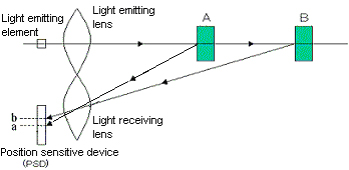Question
By what principle is the distance-setting Photoelectric Sensor detected?
Answer
PSD and the dual photodiode are used for the light receiving element and the distance to the sensing object is judged by detecting the reflected light spot position on the light receiving element.
When the light receiving element is PSD
The beam from the light emitting element (LED) is squeezed with the light emitting lens, and irradiated to the surface of the sensing object. And, a part of the diffuse reflected ray makes the spot on PSD through a light receiving lens.
The spot of light is made in "a" point when the sensing object is at the position of "A" that is the comparatively short distance and "b" point when it is at the position of "B" that is the long distance.

Therefore, if the spot position ("a" point and "b" point) on PSD is detected, the point turned on and the point turned off are set on PSD, and it can judge whether the sensing object is near or far compared with a setting distance. This is a principle of optical triangular measurement.
It is the E3G-L to use this principle.
When the light receiving element is dual photodiode
The beam from the light emitting element (LED) is squeezed with the light emitting lens, and irradiated to the surface of the sensing object. And, a part of the diffuse reflected ray makes the spot on the dual photodiode through a light receiving lens.
The position of the dual photodiode is adjusted so that N side and F side of the dual photodiode become the same amount of receiving light, and it is a setting distance. It is judged that the sensing object is nearer than a setting distance when the amount of receiving light is N>F, and judged that the sensing object is further than a setting distance when the amount of receiving light is N<F.
They are the E3Z-LS and the E3S-CL to use this principle.

No influence of the background object and the color or regardless of the amount of reflected light so that the distance-setting detects the receiving light position of the reflected light, and steady detection is possible.
Recommended Products
Other Photoelectric Sensors FAQ
-
 Can a Photoelectric Sensor with an Optical Fiber be used in an explosion-proof area?
Can a Photoelectric Sensor with an Optical Fiber be used in an explosion-proof area?
-
 What's the difference between a Reflective Fiber Unit and a Coaxial Reflective Fiber Unit?
What's the difference between a Reflective Fiber Unit and a Coaxial Reflective Fiber Unit?
-
 Our Photoelectric Sensors malfunction when the power supply of an inverter motor or other equipment is switched ON or OFF.
What's causing this, and what can we do to resolve it?
Our Photoelectric Sensors malfunction when the power supply of an inverter motor or other equipment is switched ON or OFF.
What's causing this, and what can we do to resolve it?




